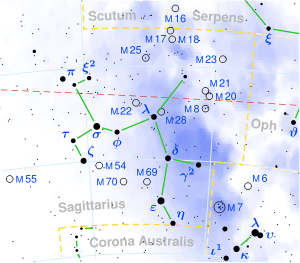HR 6801
| Observation data Epoch J2000 Equinox J2000 | |
|---|---|
| Constellation | Sagittarius |
| Right ascension | 18h 11m 43.33295s[1] |
| Declination | −23° 42′ 04.4517″[1] |
| Apparent magnitude (V) | 4.96[2] |
| Characteristics | |
| Spectral type | K0III[3] |
| U−B color index | +0.90[4] |
| B−V color index | +1.05[4] |
| Astrometry | |
| Radial velocity (Rv) | +4.40[5] km/s |
| Proper motion (μ) | RA: +7.82[1] mas/yr Dec.: -28.31[1] mas/yr |
| Parallax (π) | 12.74 ± 0.31[1] mas |
| Distance | 256 ± 6 ly (78 ± 2 pc) |
| Absolute magnitude (MV) | 0.49[2] |
| Details | |
| Mass | 2.24[6] M☉ |
| Radius | 13[7] R☉ |
| Luminosity | 81.63[2] L☉ |
| Surface gravity (log g) | 2.65[6] cgs |
| Temperature | 4,716[6] K |
| Metallicity [Fe/H] | 0.00[6] dex |
| Rotational velocity (v sin i) | 1.6[8] km/s |
| Other designations | |
| Database references | |
| SIMBAD | data |
HR 6801 is a double star in Sagittarius. The primary star is a class K0III[3] (orange giant) star. Its apparent magnitude is 4.96[2] and it is approximately 256 light years away based on parallax.[1] The secondary, B, has magnitude 11.51 and separation 43.7".[9]
It was designated as 1 Sagittarii by Flamsteed, but is now often referred to as 11 Sagittarii. Flamsteed's 11 Sgr actually refers to a different, much fainter star.[10]
References
- 1 2 3 4 5 6 Van Leeuwen, F. (2007). "Validation of the new Hipparcos reduction". Astronomy and Astrophysics. 474 (2): 653. arXiv:0708.1752. Bibcode:2007A&A...474..653V. doi:10.1051/0004-6361:20078357. Vizier catalog entry
- 1 2 3 4 Anderson, E.; Francis, Ch. (2012). "XHIP: An extended hipparcos compilation". Astronomy Letters. 38 (5): 331. arXiv:1108.4971. Bibcode:2012AstL...38..331A. doi:10.1134/S1063773712050015. Vizier catalog entry
- 1 2 Hoffleit, D.; Warren, W. H. (1995). "VizieR Online Data Catalog: Bright Star Catalogue, 5th Revised Ed. (Hoffleit+, 1991)". VizieR On-line Data Catalog: V/50. Originally published in: 1964BS....C......0H. 5050. Bibcode:1995yCat.5050....0H.
- 1 2 Mermilliod, J. C. (2006). "VizieR Online Data Catalog: Homogeneous Means in the UBV System (Mermilliod 1991)". VizieR On-line Data Catalog: II/168. Originally published in: Institut d'Astronomie. 2168. Bibcode:2006yCat.2168....0M. Vizier catalog entry
- ↑ Gontcharov, G. A. (2006). "Pulkovo Compilation of Radial Velocities for 35 495 Hipparcos stars in a common system". Astronomy Letters. 32 (11): 759. arXiv:1606.08053. Bibcode:2006AstL...32..759G. doi:10.1134/S1063773706110065.
- 1 2 3 4 Liu, Y. J.; Zhao, G.; Shi, J. R.; Pietrzynski, G.; Gieren, W. (2007). "The abundances of nearby red clump giants". Monthly Notices of the Royal Astronomical Society. 382 (2): 553. Bibcode:2007MNRAS.382..553L. doi:10.1111/j.1365-2966.2007.11852.x.
- ↑ Allende Prieto, C.; Lambert, D. L. (1999). "Fundamental parameters of nearby stars from the comparison with evolutionary calculations: Masses, radii and effective temperatures". Astronomy and Astrophysics. 352: 555. arXiv:astro-ph/9911002. Bibcode:1999A&A...352..555A. Vizier catalog entry
- ↑ De Medeiros, J. R.; Alves, S.; Udry, S.; Andersen, J.; Nordström, B.; Mayor, M. (2014). "A catalog of rotational and radial velocities for evolved stars". Astronomy & Astrophysics. 561: A126. arXiv:1312.3474. Bibcode:2014A&A...561A.126D. doi:10.1051/0004-6361/201220762. Vizier catalog entry
- ↑ Mason, Brian D.; Wycoff, Gary L.; Hartkopf, William I.; Douglass, Geoffrey G.; Worley, Charles E. (2001). "The 2001 US Naval Observatory Double Star CD-ROM. I. The Washington Double Star Catalog". The Astronomical Journal. 122 (6): 3466. Bibcode:2001AJ....122.3466M. doi:10.1086/323920. Vizier catalog entry
- ↑ Wagman, M. (August 1987). "Flamsteed's Missing Stars". Journal for the History of Astronomy. 18 (3): 212. Bibcode:1987JHA....18..209W. doi:10.1177/002182868701800305.
This article is issued from
Wikipedia.
The text is licensed under Creative Commons - Attribution - Sharealike.
Additional terms may apply for the media files.
